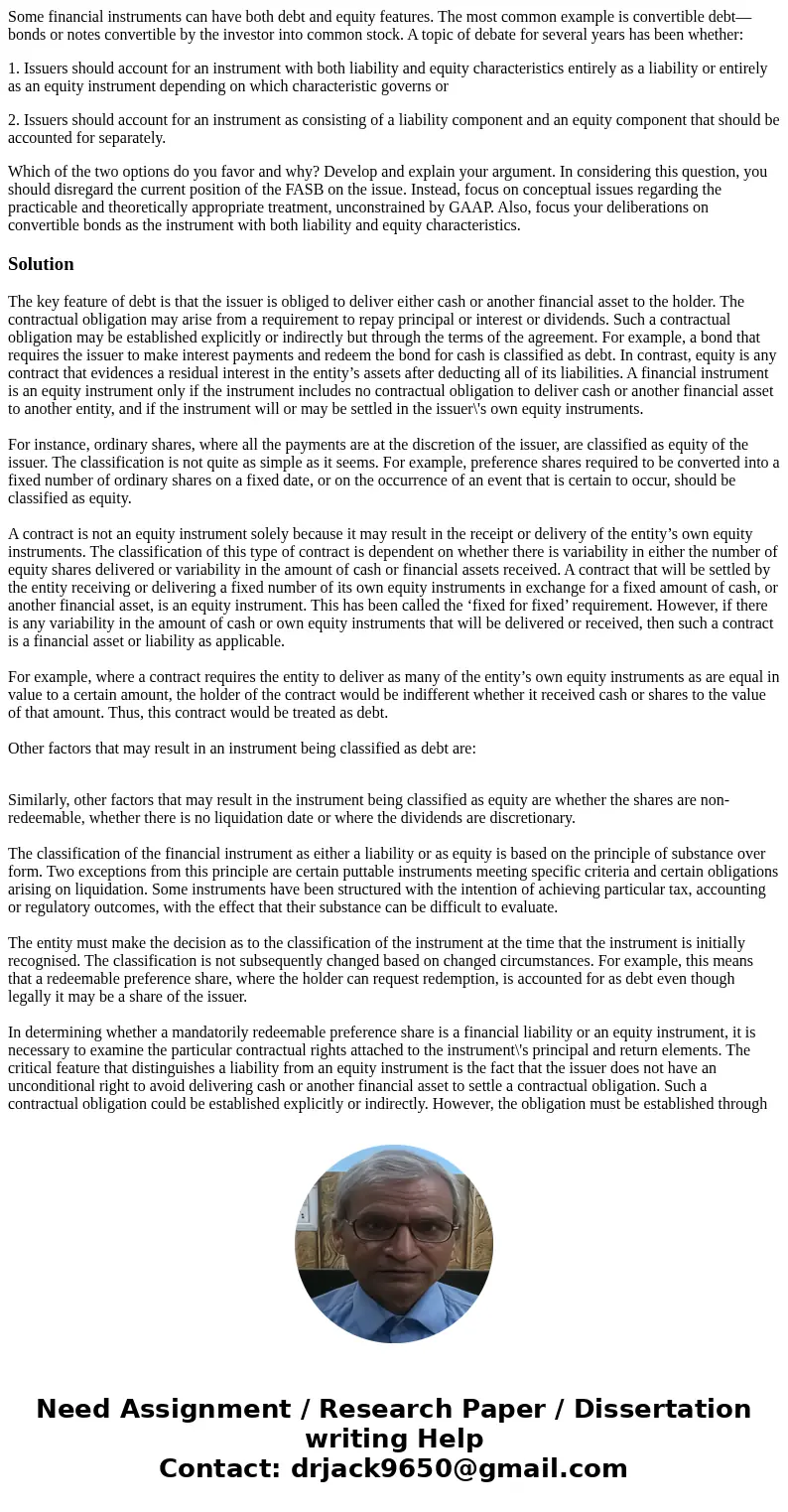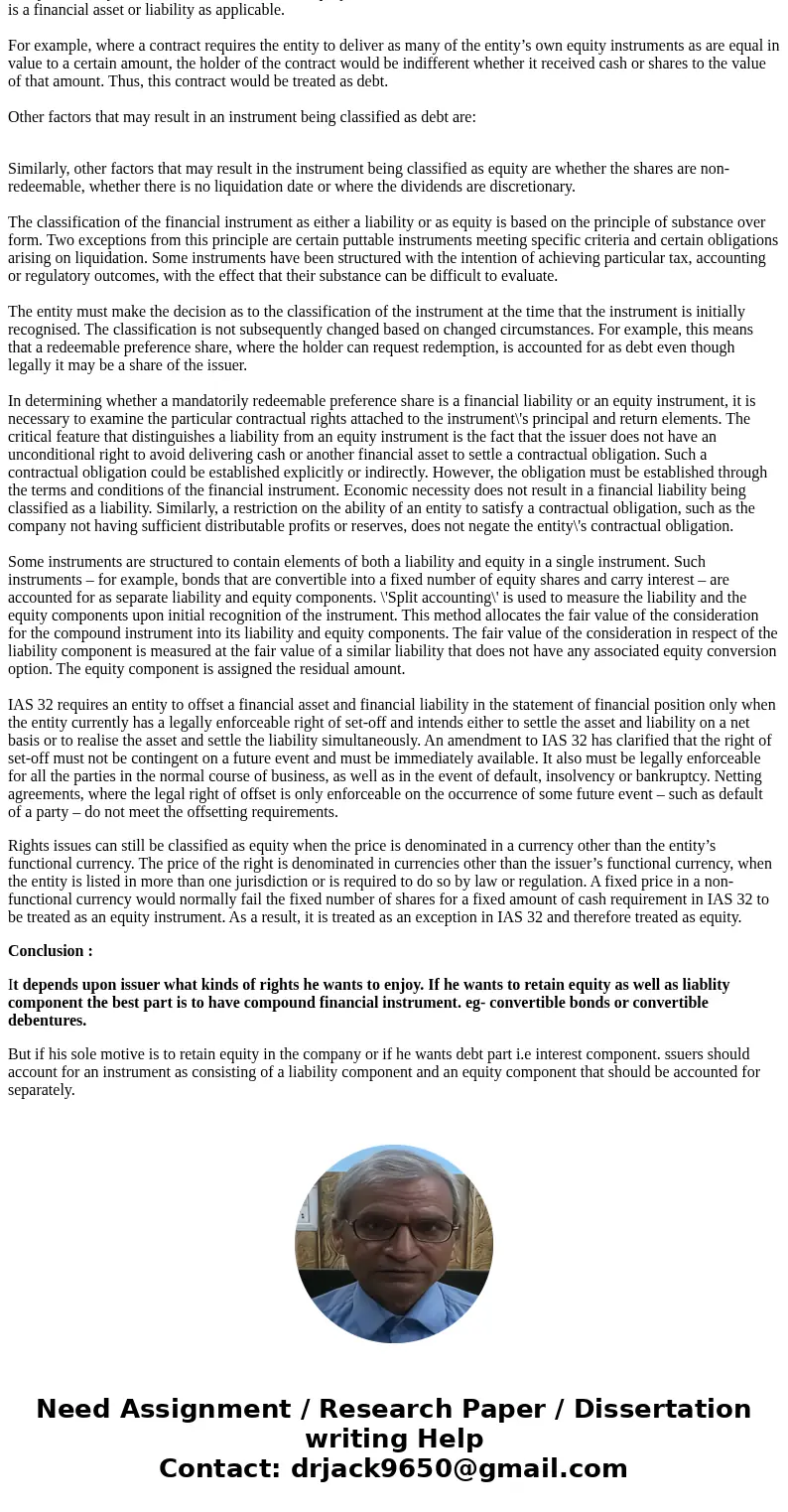Some financial instruments can have both debt and equity fea
Some financial instruments can have both debt and equity features. The most common example is convertible debt— bonds or notes convertible by the investor into common stock. A topic of debate for several years has been whether:
1. Issuers should account for an instrument with both liability and equity characteristics entirely as a liability or entirely as an equity instrument depending on which characteristic governs or
2. Issuers should account for an instrument as consisting of a liability component and an equity component that should be accounted for separately.
Which of the two options do you favor and why? Develop and explain your argument. In considering this question, you should disregard the current position of the FASB on the issue. Instead, focus on conceptual issues regarding the practicable and theoretically appropriate treatment, unconstrained by GAAP. Also, focus your deliberations on convertible bonds as the instrument with both liability and equity characteristics.
Solution
The key feature of debt is that the issuer is obliged to deliver either cash or another financial asset to the holder. The contractual obligation may arise from a requirement to repay principal or interest or dividends. Such a contractual obligation may be established explicitly or indirectly but through the terms of the agreement. For example, a bond that requires the issuer to make interest payments and redeem the bond for cash is classified as debt. In contrast, equity is any contract that evidences a residual interest in the entity’s assets after deducting all of its liabilities. A financial instrument is an equity instrument only if the instrument includes no contractual obligation to deliver cash or another financial asset to another entity, and if the instrument will or may be settled in the issuer\'s own equity instruments.
For instance, ordinary shares, where all the payments are at the discretion of the issuer, are classified as equity of the issuer. The classification is not quite as simple as it seems. For example, preference shares required to be converted into a fixed number of ordinary shares on a fixed date, or on the occurrence of an event that is certain to occur, should be classified as equity.
A contract is not an equity instrument solely because it may result in the receipt or delivery of the entity’s own equity instruments. The classification of this type of contract is dependent on whether there is variability in either the number of equity shares delivered or variability in the amount of cash or financial assets received. A contract that will be settled by the entity receiving or delivering a fixed number of its own equity instruments in exchange for a fixed amount of cash, or another financial asset, is an equity instrument. This has been called the ‘fixed for fixed’ requirement. However, if there is any variability in the amount of cash or own equity instruments that will be delivered or received, then such a contract is a financial asset or liability as applicable.
For example, where a contract requires the entity to deliver as many of the entity’s own equity instruments as are equal in value to a certain amount, the holder of the contract would be indifferent whether it received cash or shares to the value of that amount. Thus, this contract would be treated as debt.
Other factors that may result in an instrument being classified as debt are:
Similarly, other factors that may result in the instrument being classified as equity are whether the shares are non-redeemable, whether there is no liquidation date or where the dividends are discretionary.
The classification of the financial instrument as either a liability or as equity is based on the principle of substance over form. Two exceptions from this principle are certain puttable instruments meeting specific criteria and certain obligations arising on liquidation. Some instruments have been structured with the intention of achieving particular tax, accounting or regulatory outcomes, with the effect that their substance can be difficult to evaluate.
The entity must make the decision as to the classification of the instrument at the time that the instrument is initially recognised. The classification is not subsequently changed based on changed circumstances. For example, this means that a redeemable preference share, where the holder can request redemption, is accounted for as debt even though legally it may be a share of the issuer.
In determining whether a mandatorily redeemable preference share is a financial liability or an equity instrument, it is necessary to examine the particular contractual rights attached to the instrument\'s principal and return elements. The critical feature that distinguishes a liability from an equity instrument is the fact that the issuer does not have an unconditional right to avoid delivering cash or another financial asset to settle a contractual obligation. Such a contractual obligation could be established explicitly or indirectly. However, the obligation must be established through the terms and conditions of the financial instrument. Economic necessity does not result in a financial liability being classified as a liability. Similarly, a restriction on the ability of an entity to satisfy a contractual obligation, such as the company not having sufficient distributable profits or reserves, does not negate the entity\'s contractual obligation.
Some instruments are structured to contain elements of both a liability and equity in a single instrument. Such instruments – for example, bonds that are convertible into a fixed number of equity shares and carry interest – are accounted for as separate liability and equity components. \'Split accounting\' is used to measure the liability and the equity components upon initial recognition of the instrument. This method allocates the fair value of the consideration for the compound instrument into its liability and equity components. The fair value of the consideration in respect of the liability component is measured at the fair value of a similar liability that does not have any associated equity conversion option. The equity component is assigned the residual amount.
IAS 32 requires an entity to offset a financial asset and financial liability in the statement of financial position only when the entity currently has a legally enforceable right of set-off and intends either to settle the asset and liability on a net basis or to realise the asset and settle the liability simultaneously. An amendment to IAS 32 has clarified that the right of set-off must not be contingent on a future event and must be immediately available. It also must be legally enforceable for all the parties in the normal course of business, as well as in the event of default, insolvency or bankruptcy. Netting agreements, where the legal right of offset is only enforceable on the occurrence of some future event – such as default of a party – do not meet the offsetting requirements.
Rights issues can still be classified as equity when the price is denominated in a currency other than the entity’s functional currency. The price of the right is denominated in currencies other than the issuer’s functional currency, when the entity is listed in more than one jurisdiction or is required to do so by law or regulation. A fixed price in a non-functional currency would normally fail the fixed number of shares for a fixed amount of cash requirement in IAS 32 to be treated as an equity instrument. As a result, it is treated as an exception in IAS 32 and therefore treated as equity.
Conclusion :
It depends upon issuer what kinds of rights he wants to enjoy. If he wants to retain equity as well as liablity component the best part is to have compound financial instrument. eg- convertible bonds or convertible debentures.
But if his sole motive is to retain equity in the company or if he wants debt part i.e interest component. ssuers should account for an instrument as consisting of a liability component and an equity component that should be accounted for separately.


 Homework Sourse
Homework Sourse